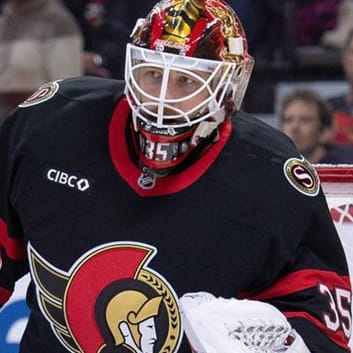The puck will drop on the 2022-23 NHL season Oct. 7, with the Sharks and Predators getting things started from Prague. Stateside action will follow soon after, starting Oct. 11, and Yahoo Daily Fantasy Hockey (DFS) contests will be available every day on which there's at least one regular season or playoff hockey game. Yahoo offers both multi-game and single-game DFS contests. The strategies below have multi-game contests in mind, though some aspects apply to both formats, and you can scroll to the bottom for a section on single-game contests.
Like other DFS sites, Yahoo employs a salary cap format, assigning a valuation to each player. It's your responsibility to build a lineup of two goalies, two centers, three wingers (can be left or right wings) and two defensemen while staying under the salary cap. The two-goalie lineup requirement adds an extra layer of strategy to Yahoo's DFS contests compared to those on other sites, as you can pay up for two top netminders while going with bargains at other positions, save money for top skaters with cheap sleepers in net or opt for something in between.
Eligible lineups cannot have more than six players from a single team and must have at least one player from three different NHL teams. Skaters get six fantasy points for a goal, four for an assist, two for each positive plus-minus rating point (and minus-2 for each negative), 0.9 fantasy points per shot, one point for a blocked shot, and two points for a power-play point. Goalies score five fantasy points for a win, minus-3 for each goal against, 0.6 per save, and five for a shutout.
Now that we've covered what constitutes an eligible lineup, let's move on to how to build a successful one:
Be Mindful Of Payout Structure
There are two main types of multi-game NHL DFS contests on Yahoo: Guaranteed Prize Pool Tournaments (GPP) and Cash Games. The biggest prizes can be won in GPP contests, which have a top-heavy payout structure. Finding success in GPP contests often requires a high-risk, high-reward approach. Calculated risks you can take include building around boom-or-bust types rather than consistent scorers, as well as going against the grain with a stack from an underdog or normally low-scoring team.
Conversely, cash games are 50/50 and Double Up contests which pay out half or just under half of participants. In cash games, your prize for finishing first or snagging the last paid spot is the same, so you should prioritize floor over ceiling. Rather than trying to build a unique lineup with upside, your approach for cash games should revolve around locking in chalk plays, and you shouldn't mind if most or all of your players are popular picks in others' lineups as well.
Use Betting Info To Guide You
Mobile sports betting has proliferated rapidly across the United States in recent months, but even if you aren't in an eligible location or choose not to partake, perusing betting lines can play a key role when crafting your lineup. Yahoo DFS contests have the odds and over/unders of every game in a banner across the top, which is among the numerous quality of life features that help separate Yahoo from other DFS sites.
Players on favorites are obviously more likely to find success than those on underdogs, but looking at expected goal totals can often help you find the best DFS value plays. High-scoring games can lead to fantasy success for both teams, while low-scoring affairs may not feature much productivity from either side's skaters but create ripe conditions for goalies to stop pucks and deliver bang for the buck. In addition to informing your lineup choices, betting lines can help you surmise which teams and players other participant's lineups will be built around in a particular slate.
Don't Forget Power-Play Stacks
If you're playing DFS contests, you've probably heard of stacking by now. Stacking – or building around teammates who share the ice – helps maximize your upside and is a common strategy in all contest formats. The obvious way to stack is with multiple forwards from the same line, often with an offensive-minded defenseman thrown in to boot. Since the Yahoo DFS format rewards positive plus-minus contributions, you get an additional bonus for even-strength goals. For instance, if you lock in Rangers linemates Chris Kreider and Mika Zibanejad, a Kreider goal assisted by Zibanejad at even strength will net you 14.9 fantasy points in one fell swoop (six for the goal, four for the assist, two each for the plus-1 rating and 0.9 for the shot).
An overlooked but equally effective stacking strategy involves grouping members of the same power-play unit. The Kreider-from-Zibanejad scenario above occurred less often than you would think last season, as only 23 of Kreider's 52 goals in 2021-22 came at even strength. Stacking two Rangers left wings in Artemi Panarin and Kreider is less intuitive, but that combination delivered plenty of success last year, as Kreider led the league with 26 power-play goals while Panarin was two power-play assists shy of Connor McDavid's league-high 34. A Kreider-from-Panarin power-play goal would also net you 14.9 fantasy points, replacing the rating boost with two fantasy points apiece for the power-play points. Especially in GPP contests that can reward less obvious combinations like Kreider and Panarin, don't forget about stacks from prolific power plays such as New York's.
Adjust To New Info
The titular advice in this section is relevant on both long and short timescales, as well as on both the individual and team level. The Canucks went from sixth-most goals allowed in 2020-21 to the seventh-fewest last season. Those who picked up on the improvement early and stopped stacking against Vancouver while exploiting the decline of the Canadiens – from 14th-most goals allowed (2.95 per game) to a league-high 3.87 – got a few weeks of excellent value before the salaries of players facing those teams adjusted.
On an individual level, it's all about spotting breakouts or declines early. Johnny Gaudreau consistently outplayed his valuation early in 2021-22 and went on to post 115 points in 82 games after failing to reach a point per game in the previous two seasons; conversely, Jakob Chychrun went from the leading goal-scorer among defensemen to a net negative on many nights as the bottom fell out for the Coyotes. Hot streaks and shifting lineup assignments will continue to create fluctuations in value throughout the season, and while the Yahoo pricing algorithm will adjust between contests, players' valuations will be locked in as soon as a contest launches.
Spotting breakout players and teams early will help you gain an edge, but so will adjusting to breaking news on the day of a contest. That news can be as important as an injury to a top-line forward – which can create a value opportunity for the player taking his place or the opposing goalie facing a depleted offense – or as commonplace as a starting goalie announcement; opposing skaters are far likelier to score on the Rangers if Jaroslav Halak's in net rather than Igor Shesterkin.
Single-Game Contest Details
The robust Daily Fantasy Hockey selection on Yahoo includes single-game contests in addition to the multi-game options detailed above. A single-game contest lineup consists of five players regardless of position, including one superstar slot that will have a 1.5X multiplier on its fantasy point total. The key to success in this format is selecting a productive superstar, so you will usually want to use either a goalie or star skater in this spot. Your lineup must feature at least one player from both teams, but you will generally want to go heavy on whichever team you believe will win, so a split of four players from one team and one from the other is the most common lineup strategy. The salary cap will prevent you from just taking the expected top performers, so make sure to have one or two upside value plays lined up when planning out your single-game contest lineup on Yahoo.








































